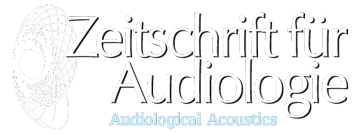Why the duck is reprimanded by the dog: Possible new ways in audiology with the »Oldenburg Linguistically and Audiologically Controlled Sentences«
Warum die Ente der Hund tadelt: Mögliche neue Wege in der Audiologie mit den »Oldenburger Linguistisch und Audiologisch Kontrollierten Sätzen«
Verena Nicole Uslar 1, Rebecca Carroll 1, Dorothea Wendt 1, Esther Ruigendijk 2, Thomas Brand 3
1 Fakultät für Medizin und Gesundheitswissenschaften, Department für medizinische Physik und Akustik, Medizinische Physik, Carl von Ossietzky University Oldenburg, Deutschland
2 Fakultät für Sprach und Kulturwissenschaften, Institut für Niederlandistik, Carl von Ossietzky University Oldenburg, Deutschland
3 Medizinische Physik, Institut für Physik, Carl von Ossietzky University Oldenburg, Deutschland
Abstract | The »Oldenburg Linguistically and Audiologically Controlled Sentences« (OLACS) form a new corpus of speech material for audiological and psycholinguistic measurements. OLACS contain sentences of seven different sentence types, which vary in their syntactic complexity. All sentences are grammatically correct but have only little semantic predictability. The OLACS corpus is unique because it considers the homogeneity of different linguistic as well as audiological parameters. For instance, we controlled for the number of syllables and words, the semantics of words used in the sentences, and the phoneme distribution, as well as for the plausibility of the sentences and the linguistic complexity (especially regarding the syntactic complexity). Finally, we controlled for the acoustical intelligibility during an extensive evaluation procedure with speech intelligibility measurements. The OLACS corpus moreover features compatible pictures, which were developed for a subset of the OLACS. Currently, OLACS are used in a number of different experimental setups, such as speech intelligibility measurements, reaction time studies, and eye-tracking experiments. Using OLACS in speech intelligibility measurements allows us to investigate the effect of linguistic complexity on speech intelligibility. Experiments, which measure reaction times or investigate the eye movements during sentence comprehension can reveal when exactly comprehension problems arise while listening to a sentence. Thus, using OLACS in these various experimental designs in the AULIN project allows us to systematically distinguish between speech intelligibility (i. e. mostly pure word recall as measured in current audiological setups), and the true understanding of speech by using alternate measures, which rely more strongly on the correct interpretation of the presented sentences. This distinction seems to be important because – as more and more studies show – speech intelligibility measures alone do not seem to be sufficient to, for instance, capture listening effort or to explain the acceptance or the benefit of a hearing aid by a specific user. Also, a clear distinction between speech intelligibility and speech comprehension seems to be important to better understand speech processing in general. With the varying levels of complexity OLACS could be a means to that end.
Schlüsselwörter: OLAKS, Sprachverständlichkeitsmessungen, Reaktionszeit, Augenbewegungen, Kognition
